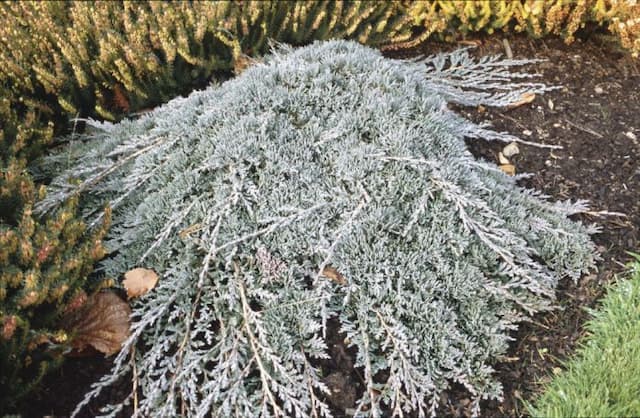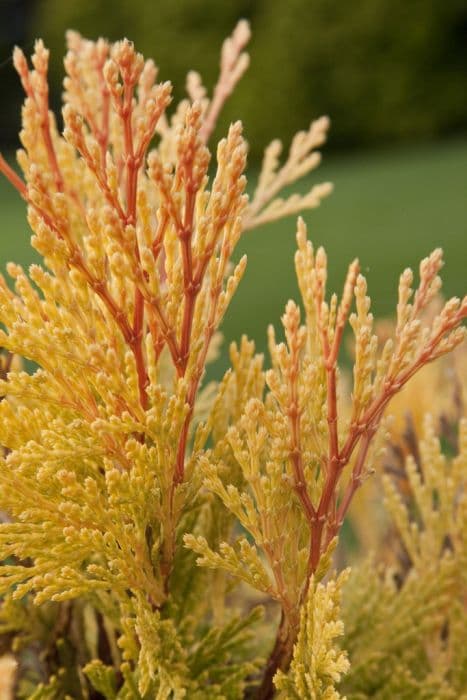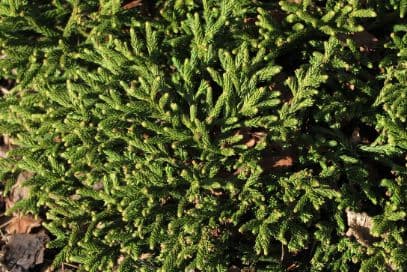Koster's False Cypress Chamaecyparis obtusa 'Kosteri'

ABOUT
The 'Kosteri' is a variety of the Hinoki cypress that features dense, compact foliage. The leaves of this ornamental conifer are pleasantly green and may have a hint of golden-yellow at the tips, especially when exposed to full sun. Its foliage is arranged in flat sprays and consists of small, scale-like leaves that are soft to the touch, contributing to its lush texture. The leaves overlap tightly, creating a feathery look that is aesthetically pleasing throughout the year. The overall shape of this cultivar is gracefully curved, with arching branches that give it a sculptural quality, making it a favored choice for many gardeners. During its slow-growing life, it develops into a somewhat rounded form, making it a good choice as a feature plant in landscape designs. Its appearance is further highlighted by the reddish-brown bark, which may exfoliate in thin strips on mature specimens, adding to the visual interest of this plant. The cones are small, round, and not overly prominent, often blending into the foliage. Overall, the 'Kosteri' Hinoki cypress stands out with its dense foliage and pleasant coloration, along with its elegant, curved growth habit that gives it a distinctive presence in gardens without dominating the space. It is valued for its texture, color, and graceful appearance, which can enhance a variety of settings with its presence.
About this plant
 Names
NamesFamily
Cupressaceae
Synonyms
Hinoki Cypress, Koster's False Cypress
Common names
Chamaecyparis obtusa 'Kosteri'.
 Toxicity
ToxicityTo humans
The Hinoki cypress is not known to be toxic to humans. However, as with many plants, it is possible that individuals with certain sensitivities or allergies may experience irritation or allergic reactions after handling the plant or inhaling its pollen. Ingesting any part of the Hinoki cypress is not advised, as plant parts can be indigestible and may cause gastrointestinal discomfort or blockage. There are no well-documented cases of poisoning in humans from this plant.
To pets
The Hinoki cypress is not known to be toxic to pets. However, ingestion of plant material, such as needles or branches, by pets can lead to gastrointestinal irritation or blockage. It is always recommended to keep an eye on your pets and prevent them from eating ornamental plants as they might cause vomiting or diarrhea due to non-toxic irritants, or mechanical injury from sharp parts of the plants. Keep in mind that individual animals can have different sensitivities, and it's best to be cautious and consult a veterinarian if any unusual behavior or signs of illness appear after ingestion.
 Characteristics
CharacteristicsLife cycle
Perennials
Foliage type
Evergreen
Color of leaves
Green
Height
2-3 feet [60-90 cm]
Spread
2-4 feet [60-120 cm]
Plant type
Tree
Hardiness zones
5
Native area
Japan
Benefits
 General Benefits
General Benefits- Aesthetic Appeal: 'Kosteri' Hinoki Cypress is prized for its attractive, fan-shaped foliage and dense growth habit, making it an excellent choice for ornamental purposes in gardens and landscapes.
- Low Maintenance: It is relatively easy to care for, requiring minimal pruning and can do well in a variety of soil types, as long as they are well-drained.
- Erosion Control: Its root system helps stabilize the soil, making it a good choice for sloped areas where erosion may be a concern.
- Privacy Screen: With its thick foliage, it can be used as an effective natural privacy screen or hedge.
- Noise Reduction: The dense growth of the 'Kosteri' Hinoki Cypress can help dampen noise, making it suitable for planting in urban areas or near roads.
- Wildlife Habitat: It can serve as a habitat for birds, offering protection and nesting sites.
- Year-Round Interest: It is an evergreen species, providing color and structure in the landscape throughout all seasons.
 Medical Properties
Medical PropertiesThis plant is not used for medical purposes.
 Air-purifying Qualities
Air-purifying QualitiesThis plant is not specifically known for air purifying qualities.
 Other Uses
Other Uses- Hinoki cypress 'Kosteri' can be used in bonsai cultivation due to its slow growth habit and ability to be pruned into miniature tree forms.
- The aromatic wood shavings of the hinoki cypress are used in Japan for making traditional incense, offering a subtle lemon-scented aroma.
- This plant's wood is sometimes used in the construction of traditional Japanese Noh theaters, as it is believed to improve the acoustics due to its unique density and grain.
- The fine texture and natural resistance to rot make hinoki cypress lumber favorable for creating intricate woodworking items like puzzle boxes and small carvings.
- The hinoki cypress is often planted in memorial gardens and cemeteries in Japan, symbolizing eternity and the eternal cycle of nature.
- The leaves and branches of hinoki cypress can be used to create natural wreaths and decorations, especially during the holiday season.
- Hinoki cypress oil, extracted from the wood and foliage, is used in aromatherapy and perfumery for its stress-relieving and rejuvenating properties.
- Thin slices of hinoki wood are favored for serving certain types of sushi due to its antibacterial properties and subtle woodsy scent that can complement the dish.
- In Japan, small tablets of hinoki wood, known as "Hinoki-buta," are used to preserve the freshness of mochi (rice cakes) by absorbing excess moisture.
- The beautifully patterned wood of the hinoki cypress is desirable for making luxury baths and spas, particularly in Japan, where soaking tubs called "ofuro" are traditionally made from this wood.
Interesting Facts
 Feng Shui
Feng ShuiThe Hinoki cypress is not used in Feng Shui practice.
 Zodiac Sign Compitability
Zodiac Sign CompitabilityThe Hinoki cypress is not used in astrology practice.
 Plant Symbolism
Plant Symbolism- Longevity: Chamaecyparis obtusa 'Kosteri', commonly known as Hinoki Cypress, often symbolizes longevity due to its long lifespan and enduring nature as an evergreen tree.
- Peace: The Hinoki Cypress is also associated with peace and tranquility, as its natural habitats and the serene appearance of the tree evoke a sense of calmness and restfulness.
- Purity: In Japan, where the Hinoki Cypress is native, the wood is used for building temples and shrines, lending the tree a symbolic connection to purity and sacred spaces.
- Strength: The wood of the Hinoki Cypress is known for its strength and resistance to rot, making it symbolize resilience and the ability to withstand challenges.
 Water
WaterFor the Hinoki cypress, it is important to maintain consistent moisture without overwatering. Water this conifer deeply and thoroughly about once a week, but make sure the soil has good drainage to prevent standing water. Use approximately 1 to 2 gallons per watering session for a young tree, adjusting for rainfall. During hot, dry periods, an extra watering may be necessary. In winter, reduce watering to when the soil is dry to the touch.
 Light
LightThe Hinoki cypress thrives in full sun to partial shade conditions. It performs best when it receives at least four to six hours of direct sunlight daily. A spot that gets morning sun and afternoon shade is ideal to protect it from the intense late-day sun, especially in hotter climates.
 Temperature
TemperatureThe Hinoki cypress is cold hardy and can withstand temperatures as low as 0°F but may suffer in prolonged conditions colder than that. The ideal growth temperatures range between 50°F and 70°F. Extreme heat above 90°F can stress the plant, so providing some afternoon shade during the hottest parts of summer can be beneficial.
 Pruning
PruningPruning the Hinoki cypress should be done to shape the plant or remove dead and diseased branches. The best time to prune is in late winter or early spring before new growth starts. Minimal pruning is needed, and it should be done sparingly, as this plant naturally forms a pleasing shape. Remove only the necessary branches each year to conserve its natural form.
 Cleaning
CleaningAs needed
 Soil
SoilThe Hinoki cypress 'Kosteri' thrives best in a soil mix with good drainage, ideally composed of equal parts of loamy soil, peat, and sharp sand or perlite. The preferred soil pH for this plant is slightly acidic to neutral, ranging from 5.0 to 7.0.
 Repotting
RepottingHinoki cypress 'Kosteri' should be repotted every 2-3 years or when it outgrows its current pot to maintain its health and accommodate its growing root system.
 Humidity & Misting
Humidity & MistingThe Hinoki cypress 'Kosteri' prefers moderate humidity levels but is adaptable to a wide range of conditions as long as it's not in an excessively dry environment.
 Suitable locations
Suitable locationsIndoor
Place in well-lit area; avoid direct strong sunlight.
Outdoor
Plant in well-drained soil, part shade to full sun.
Hardiness zone
4-8 USDA
 Life cycle
Life cycleThe Dwarf Hinoki Cypress 'Kosteri' starts its life as a seed, typically produced after pollination between male and female cones which occurs in spring. After germination, which can take up to a year, the seedling begins to establish a root system and shoot, entering a slow growth stage due to its dwarf nature. As it matures, the Dwarf Hinoki Cypress 'Kosteri' develops its characteristic curved, fan-shaped foliage and a woody stem over several years. It continues to grow slowly, often requiring several decades to reach its full size of roughly 3-6 feet tall and wide. Throughout its life, which can exceed well over a century in ideal conditions, it will annually produce small cones and require minimal pruning to maintain its shape. Entering its senescence phase, growth slows almost to a halt before the plant eventually dies, completing its life cycle.
 Propogation
PropogationPropogation time
Early Spring
The most popular method of propagation for the Hinoki cypress 'Kosteri' is through semi-hardwood cuttings. This technique is usually performed in late summer when the wood is semi-ripe. A cutting, which is a section of the plant stem taken from the current year’s growth, is snipped at a length of about 4 to 6 inches (10 to 15 cm). The lower leaves are stripped off, and the base of the cutting is often treated with a rooting hormone to encourage root growth. The cutting is then inserted into a well-draining soil mix, ensuring at least two sets of leaves remain above the soil surface. The cutting should be placed in a warm, humid environment out of direct sunlight to encourage rooting. It generally takes a few weeks for the cutting to establish a strong root system.









